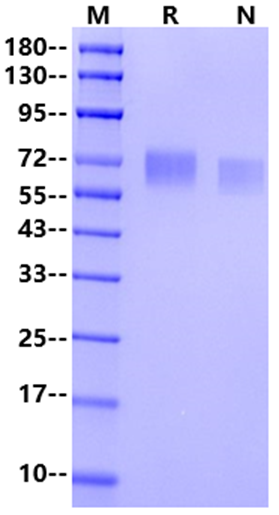Gln28-Glu469, with C-terminal 8*His QDSPPQILVHPQDQLFQGPGPARMSCQASGQPPPTIRWLLNGQPLSMVPPDPHHLLPDGTLLLLQPPARGHAHDGQALSTDLGVYTCEASNRLGTAVSRGARLSVAVLREDFQIQPRDMVAVVGEQFTLECGPPWGHPEPTVSWWKDGKPLALQPGRHTVSGGSLLMARAEKSDEGTYMCVATNSAGHRESRAARVSIQEPQDYTEPVELLAVRIQLENVTLLNPDPAEGPKPRPAVWLSWKVSGPAAPAQSYTALFRTQTAPGGQGAPWAEELLAGWQSAELGGLHWGQDYEFKVRPSSGRARGPDSNVLLLRLPEKVPSAPPQEVTLKPGNGTVFVSWVPPPAENHNGIIRGYQVWSLGNTSLPPANWTVVGEQTQLEIATHMPGSYCVQVAAVTGAGAGEPSRPVCLLLEQAMERATQEPSEHGPWTLEQLRATLKRPEGGGSHHHHHHHH
1.Xiao, W., Pinilla-Baquero, A., Faulkner, J. et al. Robo4 is constitutively shed by ADAMs from endothelial cells and the shed Robo4 functions to inhibit Slit3-induced angiogenesis. Sci Rep 12, 4352 (2022). https://doi.org/10.1038/s41598-022-08227-8.
Roundabout homolog 4, also known as magic roundabout and ROBO4 is a member of the immunoglobulin superfamily and ROBO family. Roundabout 4 (Robo4) is a transmembrane receptor that expresses specifically in endothelial cells. ROBO4 contains two fibronectin type-III domains and two Ig-like C2-type (immunoglobulin-like) domains. ROBO4 is predominantly expressed in embryonic or tumor vascular endothelium and is considered important for vascular development and as a candidate tumor endothelial marker. ADAM10 and ADAM17 are abscisic enzymes of Robo4, and the negative regulation of their ligand Slit3 is a new control mechanism of Robo4 signaling in angiogenesis.
